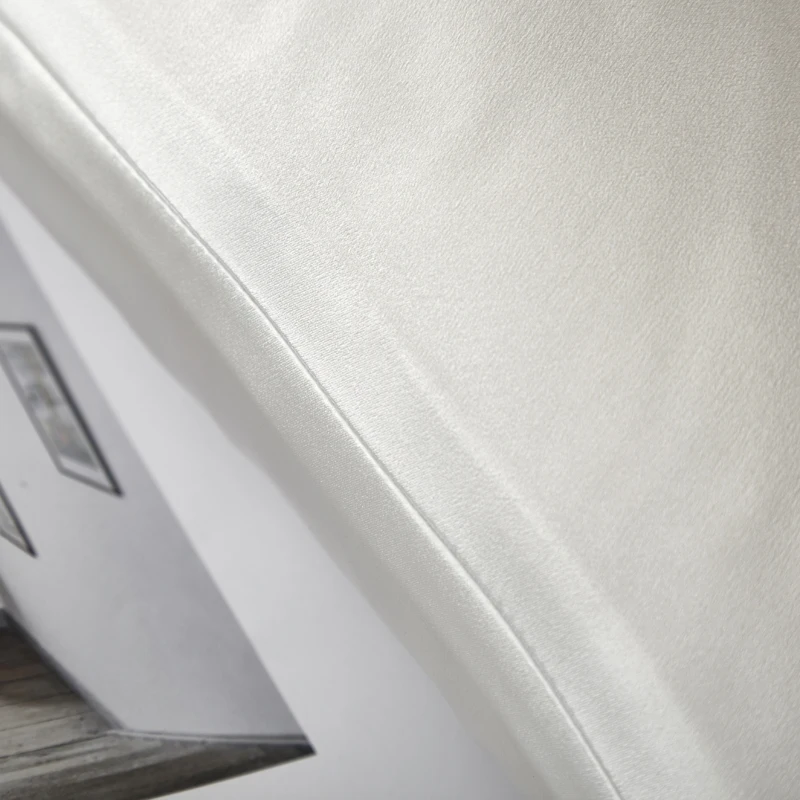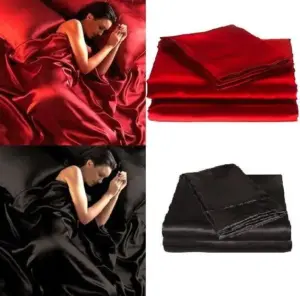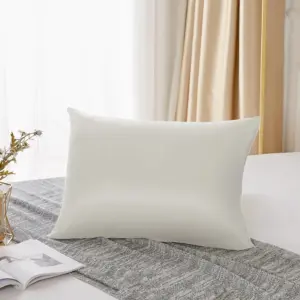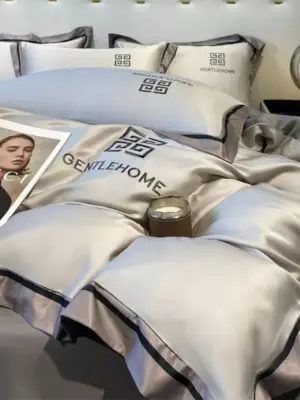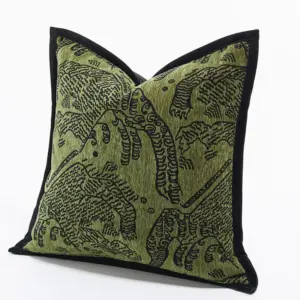Introduction: The Invisible Impact of Your Pillowcase on Hair Health
Did you know that the average person spends approximately 2,920 hours per year with their hair in direct contact with a pillowcase? That’s over 121 days annually where your hair is being affected by the material you sleep on. Yet most people overlook this crucial factor in their hair care routine.
Traditional cotton pillowcases, while comfortable and familiar, can actually be your hair’s worst enemy. The rough cotton fibers create friction against your hair throughout the night, leading to:
- Increased frizz and tangles by morning
- Gradual damage to the hair cuticle
- Excessive dryness as cotton absorbs natural oils
- Breakage, split ends, and weakened strands over time
Switching your pillowcase material is one of the simplest yet most effective changes you can make for healthier hair. This small adjustment requires no extra time in your daily routine but can dramatically improve your hair’s appearance and health.
In this comprehensive guide, you’ll discover the science behind different pillowcase materials, learn which options provide specific benefits for your hair type, and understand how to choose the right pillowcase for your needs. Drawing from research backed by trichologists and hair care professionals, we’ll explore how silk pillowcases benefit your hair and much more.
The Hidden Damage: How Standard Cotton Pillowcases Affect Your Hair
The problems with standard cotton pillowcases go far beyond just comfort—they can actively damage your hair while you sleep.
Friction Damage
Cotton fibers have a microscopic structure that’s surprisingly rough and porous. When examined under magnification, cotton resembles tiny hooks and loops that catch and snag hair strands. This creates significant friction as you move during sleep, lifting the hair’s protective cuticle layer. Over time, this friction weakens the hair structure, leading to breakage, split ends, and frizz.
Moisture Theft
One of cotton’s most praised qualities—high absorbency—is actually detrimental for hair health. Cotton can absorb up to 27 times its weight in water, which means it actively wicks moisture away from your hair. This nightly moisture loss:
- Strips away natural oils that protect and nourish your hair
- Wastes expensive hair products applied before bed
- Creates dry, brittle strands more prone to breakage
- Exacerbates existing dryness issues, especially in curly or textured hair
Hair Structure Disruption
The constant movement against cotton disrupts your hair’s structure in multiple ways:
- Carefully styled hair becomes disheveled
- Curls get flattened and lose definition
- New tangles and knots form during the night
- Hair becomes more difficult to manage in the morning
Different Hair Types, Different Problems
While cotton pillowcases affect all hair types negatively, they cause specific issues depending on your hair texture:
- Fine hair: Experiences more breakage and static electricity
- Curly/textured hair: Suffers from increased frizz, disrupted curl patterns, and severe moisture loss
- Color-treated hair: Shows faster fading as friction damages the cuticle that holds color molecules
- All hair types: Deal with more tangles and pronounced “bed head”
The daily damage from silk versus cotton pillowcases creates a cumulative effect that becomes increasingly difficult to remedy with standard hair care products.
Essential Properties of Hair-Friendly Pillowcase Materials
Not all pillowcase materials are created equal when it comes to hair care. Understanding these key properties helps you make an informed choice:
Surface Smoothness
The most critical factor for hair health is the smoothness of the fabric surface. Materials with a high smoothness factor allow hair to glide freely as you move during sleep, preventing the pulling, snagging, and friction that damages hair strands. This smoothness preserves your hair’s cuticle layer, which is essential for shine, moisture retention, and overall strength.
Moisture Management
Healthy hair relies on balanced moisture. The ideal pillowcase material maintains your hair’s natural hydration levels rather than absorbing them. Materials vary significantly in how they interact with moisture:
– Some actively draw moisture from hair (high absorption)
– Others repel moisture entirely (water-resistant)
– The best options maintain a balanced environment (moisture-regulating)
Temperature Regulation
How a fabric handles temperature affects not just sleep comfort but also scalp health. Breathable materials that regulate temperature help control oil production and maintain a healthy scalp environment, which forms the foundation for healthy hair growth.
Material Density
The density of a fabric—measured in momme for silk, thread count for cotton and other materials—impacts both durability and performance. Understanding how to choose silk pillowcases by momme weight helps ensure you get a product that delivers the right balance of longevity and benefits.
Hypoallergenic Properties
For those with sensitive scalps or allergies, hypoallergenic materials prevent irritation that can disrupt hair growth cycles and cause excessive shedding or brittleness.
Silk Pillowcases: The Gold Standard for Hair Protection
Silk pillowcases have earned their reputation as the premier choice for hair protection, offering benefits that other materials simply cannot match.
What Is Silk?
True silk is a natural protein fiber produced by silkworms, specifically Bombyx mori silkworms that feed exclusively on mulberry leaves. This creates what we know as mulberry silk—the highest quality silk available. Silk quality is measured in momme weight, similar to thread count for cotton. For pillowcases:
- 15-18 momme: Lightweight, less durable
- 19-22 momme: Optimal balance of softness and durability for pillowcases
- 22-25 momme: Premium weight, exceptional longevity
- Above 25 momme: Ultra-luxury, heavier feel
Hair Benefits
Silk offers unparalleled advantages for hair health:
- Microscopic Smoothness: The incredibly smooth fiber structure virtually eliminates friction. Laboratory tests show silk reduces friction by approximately 43% compared to cotton.
- Protein Composition: Silk contains amino acids similar to those in human hair, creating a natural harmony that synthetic materials cannot replicate.
- Natural Moisture Balance: Unlike absorbent cotton, silk maintains your hair’s essential moisture while wicking away excess. It achieves this balance because silk fibers can absorb moisture up to 30% of their weight without feeling damp.
- Temperature Regulation: Silk naturally adjusts to body temperature, preventing the overheating that can cause scalp sweating and excess oil production.
- Style Preservation: Hair glides across silk without catching or pulling, maintaining styles, curls, and blow-outs significantly longer.
Scientific studies have confirmed these benefits aren’t just marketing claims. Research published in dermatology journals has demonstrated reduced friction coefficients and better moisture retention with silk versus cotton fabrics.
Considerations
While silk provides superior benefits, it does require specific care:
– Gentle washing with pH-neutral detergents
– Air drying away from direct sunlight
– Higher initial investment than synthetic options
However, most users find that the reduction in hair breakage from silk pillowcases justifies the cost and care requirements. With proper maintenance, a high-quality silk pillowcase can last for years, making it a worthwhile investment for long-term hair health.
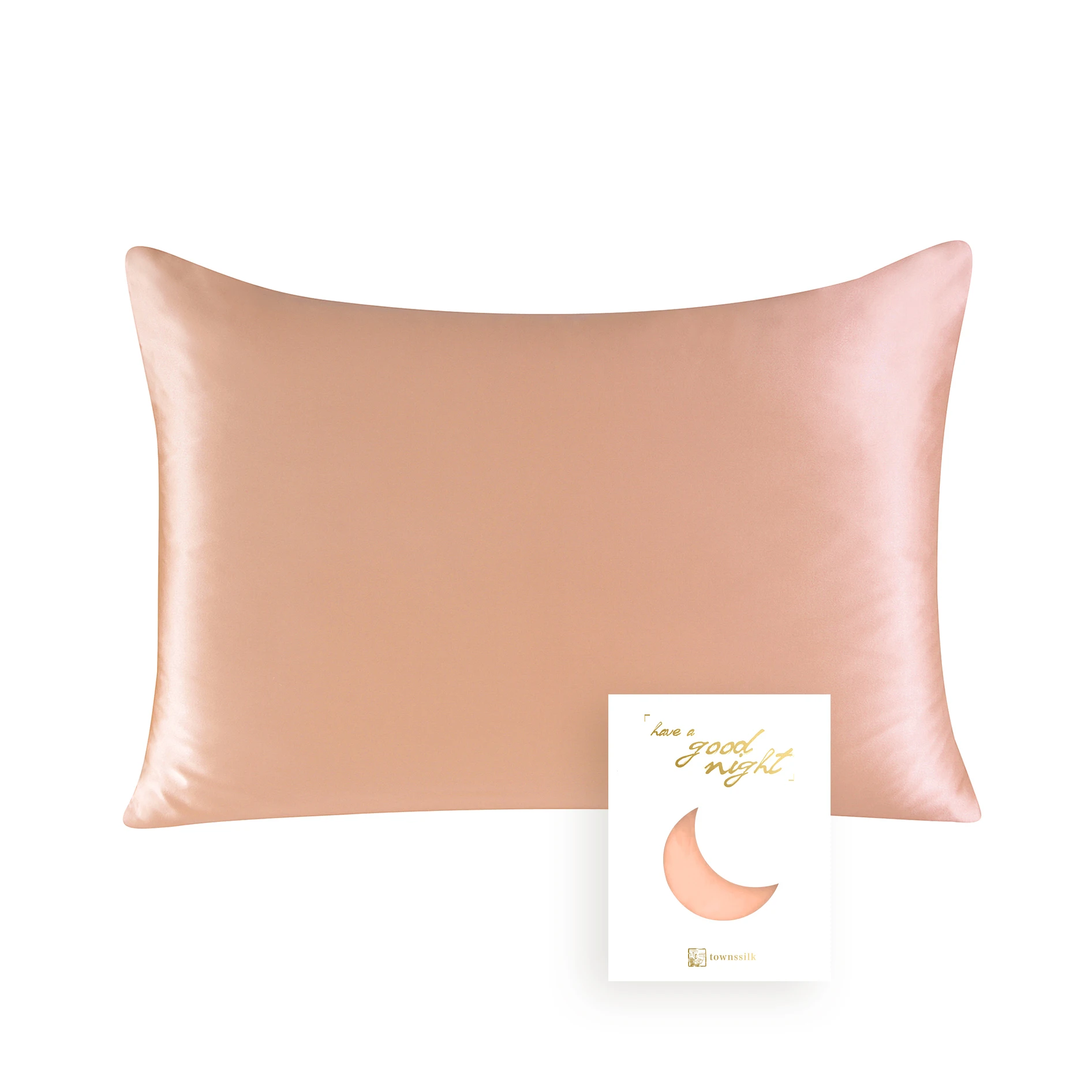
Our silk pillowcases collection offers a range of options to help you experience these benefits.
Satin Pillowcases: The Cost-Effective Alternative
For those seeking many of silk’s benefits at a lower price point, satin pillowcases offer a compelling alternative.
What Is Satin?
It’s important to understand that satin is not a specific material but rather a type of weave. This weaving technique creates a smooth, glossy surface on one side and a duller finish on the reverse. Satin pillowcases are typically made from:
- Polyester (most common)
- Nylon
- Rayon
- Sometimes blended with other fibers
The distinctive satin weave creates a smooth surface that mimics some of silk’s properties, though through different means.
Hair Benefits
Satin offers several advantages for hair care:
- Significant Friction Reduction: While not as frictionless as silk, satin provides a smooth surface that dramatically reduces snagging and pulling compared to cotton.
- Moderate Moisture Retention: Satin doesn’t absorb as much moisture as cotton, helping preserve some of your hair’s natural oils and hydration.
- Enhanced Durability: Typically more resistant to wear and tear than silk, often withstanding more frequent washing.
- Affordability: Available at various price points, making hair-friendly bedding accessible to more budgets.
- Easy Maintenance: Machine washable and often more stain-resistant than natural silk.
Differences from Silk
Despite their similar appearance and some shared benefits, satin differs from silk in several key ways:
- Lacks the protein structure that makes silk naturally compatible with hair
- Cannot regulate temperature as effectively as silk
- May generate some static electricity with certain hair types
- Doesn’t offer the same level of moisture management
- Typically has a slightly “slipperier” feel rather than silk’s soft glide
Best Uses
Satin pillowcases are ideal for:
– Those new to hair-friendly bedding who want to test benefits before investing in silk
– Children and teenagers who may not properly care for more delicate materials
– Travel pillowcases that may face harsher conditions
– Secondary bedrooms or guest rooms
Our mulberry silk pillowcases offer premium quality for those ready to upgrade from satin to true silk.
Bamboo Pillowcases: The Eco-Conscious Choice
For environmentally conscious consumers seeking hair benefits, bamboo pillowcases offer a sustainable alternative with impressive performance.
What Is Bamboo Fabric?
Bamboo fabric is derived from bamboo pulp processed into fiber. The quality and environmental impact vary significantly based on the processing method:
- Bamboo Lyocell: Created through a closed-loop system using non-toxic solvents, making it the most eco-friendly option.
- Bamboo Viscose/Rayon: Uses more chemicals in processing but still creates a soft, usable fabric.
High-quality bamboo fabric offers a silky smooth texture with natural properties beneficial for both hair and the environment.
Hair Benefits
Bamboo pillowcases provide several advantages for hair health:
- Smooth Surface: The naturally smooth fibers reduce friction against hair strands, though not quite to silk’s level.
- Superior Breathability: Excellent airflow regulation helps maintain a healthy scalp environment and prevents overheating.
- Balanced Moisture Management: While more absorbent than silk, bamboo wicks away excess moisture without stripping hair completely, making it particularly suitable for those with oilier hair or scalps.
- Natural Antimicrobial Properties: Bamboo contains a bio-agent called “bamboo kun” that reduces bacteria growth, potentially benefiting those with scalp sensitivity or acne.
Sustainability Factors
Bamboo’s environmental credentials include:
– Rapid growth rate (up to 3 feet per day for some species)
– Minimal water requirements compared to cotton
– No need for pesticides or fertilizers
– Biodegradability when properly processed
– High oxygen production and carbon dioxide absorption
Considerations
While bamboo offers many benefits, there are some considerations:
– Slightly more absorbent than silk, which may affect those with very dry hair
– Quality varies widely based on processing methods
– Requires more frequent washing than silk to maintain benefits
– May pill or wear more quickly than high-quality silk
For those interested in sustainable options, our bamboo silk sheets provide an eco-friendly alternative that still protects hair.
Other Material Options: Sateen, Microfiber, and Tencel
Beyond silk, satin, and bamboo, several other materials offer varying degrees of hair benefits.
Sateen
Sateen is to cotton what satin is to polyester—a specific weave rather than a material itself. Sateen pillowcases are made from cotton using a weaving technique that creates a smoother surface than standard cotton weaves.
- Benefits: Smoother than regular cotton, more affordable than silk, natural material
- Drawbacks: Still more absorbent and creates more friction than silk or satin
- Best for: Those who strongly prefer natural fibers but find silk too expensive
Microfiber
Microfiber pillowcases are made from ultra-fine synthetic fibers, typically polyester or nylon, that are thinner than a strand of silk.
- Benefits: Very affordable, durable, easy to clean
- Drawbacks: Can generate static electricity, less breathable, not as smooth as silk or satin
- Best for: Budget options or guest rooms
Tencel/Lyocell
Tencel is a branded form of lyocell, a sustainable fabric made from wood pulp, usually eucalyptus.
- Benefits: Eco-friendly, naturally cooling, moderate smoothness, excellent moisture management
- Drawbacks: Not as friction-reducing as silk, slightly more expensive than standard cotton
- Best for: Hot sleepers who want natural fibers with better hair protection than cotton
When comparing cotton options with silk alternatives, the differences in silk versus cotton pillowcases become clear in terms of both feel and function.
Comprehensive Comparison: Finding Your Perfect Match
When choosing the ideal pillowcase material for your hair, consider how each option performs across key factors:
| Material | Friction Reduction | Moisture Retention | Breathability | Durability | Ease of Care | Price Point | Sustainability | Best For |
|---|---|---|---|---|---|---|---|---|
| Silk | 5/5 – Virtually no friction | 5/5 – Optimal moisture balance | 4/5 – Excellent temperature regulation | 3/5 – Requires gentle care | 2/5 – Hand wash or delicate cycle | $$$ – Investment piece | 3/5 – Natural but resource-intensive | All hair types, especially damaged, curly, or fine hair |
| Satin | 4/5 – Very low friction | 3/5 – Moderate moisture retention | 3/5 – Good but can trap heat | 4/5 – Generally durable | 4/5 – Machine washable | $$ – Affordable | 2/5 – Typically synthetic | Budget-conscious, children, travel |
| Bamboo | 3/5 – Low friction | 3/5 – Balanced moisture management | 5/5 – Superior breathability | 4/5 – Durable with proper care | 3/5 – Specific washing instructions | $$ – Mid-range | 5/5 – Highly sustainable | Eco-conscious consumers, those with oily hair |
| Sateen | 3/5 – Smoother than regular cotton | 2/5 – Still absorbs moisture | 3/5 – Good breathability | 4/5 – Durable | 5/5 – Easy to wash | $$ – Affordable | 3/5 – Natural but water-intensive | Cotton lovers wanting better hair protection |
| Microfiber | 2/5 – Can create static | 2/5 – Variable moisture control | 1/5 – Limited breathability | 5/5 – Very durable | 5/5 – Easy care | $ – Very affordable | 1/5 – Synthetic, microplastic concerns | Tight budgets, guest bedrooms |
| Tencel | 3/5 – Moderately smooth | 4/5 – Good moisture management | 4/5 – Excellent cooling | 3/5 – Average longevity | 3/5 – Specific care instructions | $$ – Mid-range | 4/5 – Sustainable production | Hot sleepers, environmentally conscious |
The benefits of silk for hair during sleep consistently rank highest across most categories, explaining why it remains the gold standard for hair protection during sleep.
Matching Materials to Your Specific Hair Type
Different hair types have unique needs that certain pillowcase materials address better than others.
For Fine or Damaged Hair
Fine hair and damaged strands are particularly vulnerable to friction damage. For these hair types:
- Best Choice: Silk (19-25 momme)
- Why: The ultra-smooth surface prevents further weakening of already fragile strands. Fine hair glides across silk without catching or breaking, while damaged hair gets a break from further stress.
- Benefits: Reduced breakage, less tangling, preserved moisture, and protection for weakened sections.
For Curly and Textured Hair
Curly hair (from 3a waves to 4c coils) faces unique challenges during sleep:
- Best Choice: Silk or high-quality satin
- Why: These materials allow curls to glide without disruption, preserving definition and preventing the compression that leads to flattened sections.
- Benefits: Maintained curl pattern, reduced frizz, preserved moisture, and extended styling. Silk pillowcases for curly hair have been shown to extend the life of styles by 2-3 days.
For Oily Hair/Scalp
Those with excess oil production need balanced moisture management:
- Best Choice: Bamboo or high-quality silk
- Why: Bamboo offers excellent moisture-wicking properties without stripping hair entirely. Silk maintains balance by wicking excess oil while not over-drying the hair shaft.
- Benefits: More balanced scalp environment, reduced oil transfer to hair, extended time between washes.
For Dry, Frizz-Prone Hair
Dry hair needs to retain every bit of moisture possible:
- Best Choice: Silk (22+ momme)
- Why: Silk’s minimal absorption maintains your hair’s essential moisture overnight. Its smooth surface also prevents the friction that exacerbates frizz.
- Benefits: Enhanced shine, reduced frizz, better moisture retention, improved manageability.
For Color-Treated Hair
Protecting your color investment is crucial:
- Best Choice: Silk
- Why: By reducing friction against the hair cuticle (the outer layer that holds color molecules), silk helps prevent the mechanical damage that leads to faster color fading.
- Benefits: Extended color vibrancy, reduced fading, protection for chemically processed strands.
For Sensitive Scalps
Those with scalp conditions or sensitivities need special consideration:
- Best Choice: Silk or bamboo
- Why: Both materials offer hypoallergenic properties, with silk providing pure natural protein fibers and bamboo offering natural antimicrobial benefits.
- Benefits: Reduced irritation, fewer allergic reactions, cooler sleep environment for sensitive scalps.
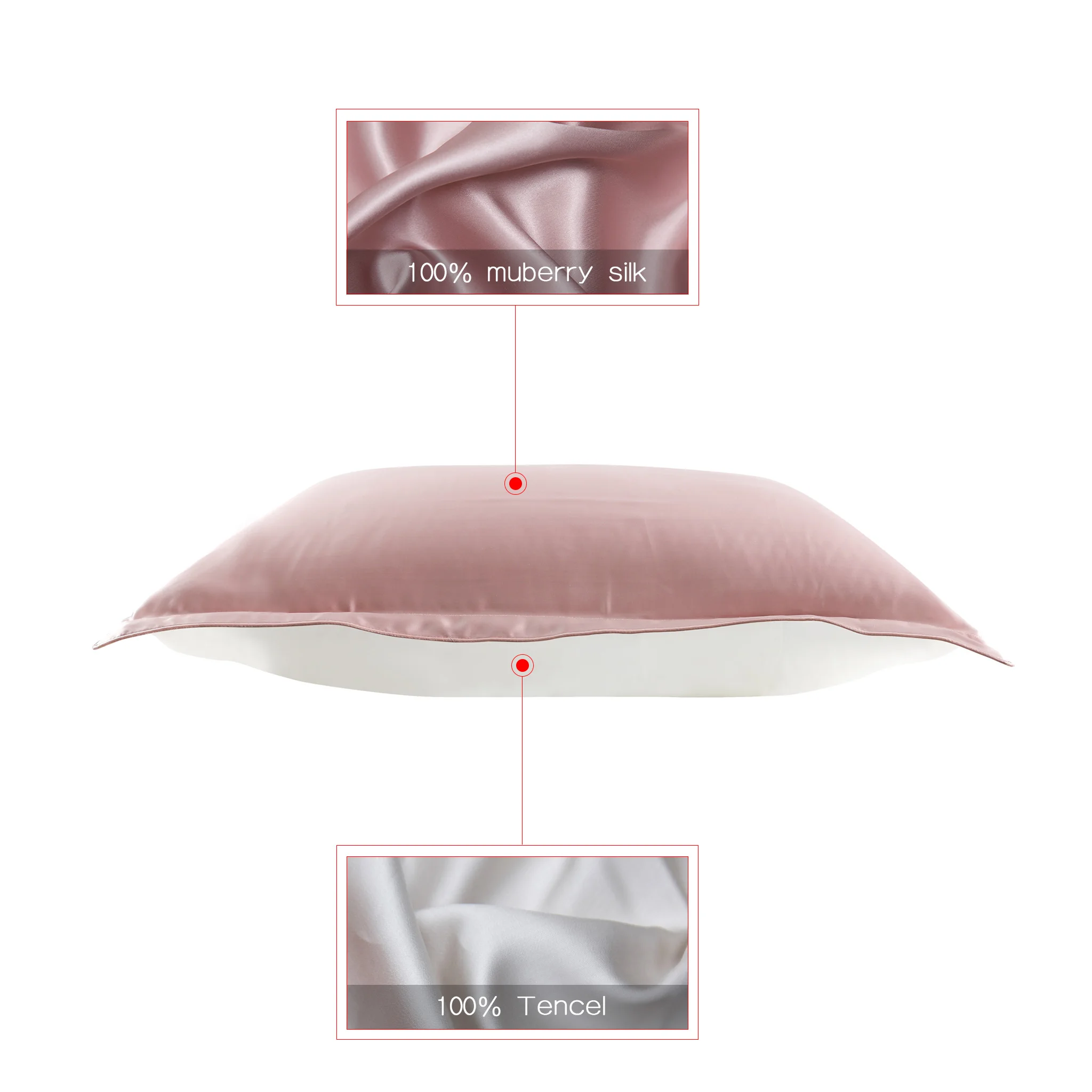
Practical Considerations Beyond Hair Benefits
While hair protection is important, several other factors should influence your pillowcase selection:
Investment Value
Higher-quality materials like silk represent long-term investments:
– Premium pillowcases often last 3-5 years with proper care
– Reduced need for styling products and heat tools saves money over time
– Less breakage means fewer haircuts to remove damaged ends
– Protected hair requires fewer treatments and masks to restore health
Budget Options
You can maximize benefits at different price points:
– High-quality satin offers many benefits at a fraction of silk’s cost
– Entry-level silk (15-16 momme) provides basic benefits for less
– Silk-cotton blends offer a compromise between performance and price
– Bamboo provides excellent value with good longevity at mid-range prices
Environmental Impact
Different materials have varying ecological footprints:
– Natural fibers like silk require specific resources but are biodegradable
– Synthetic satin creates microplastic concerns but lasts longer
– Bamboo offers exceptional sustainability when properly processed
– Production methods matter as much as the raw material itself
Sleep Quality Factors
Material choice affects your overall sleep experience:
– Temperature regulation prevents night sweats that damage hair
– Breathable fabrics improve sleep quality, indirectly benefiting hair health
– Comfort encourages proper sleeping positions that reduce hair friction
Multi-Benefit Considerations
Most hair-friendly materials offer additional advantages:
– Reduced facial wrinkles and creasing
– Less skin irritation and breakouts
– Longer-lasting skincare products
– Better overall sleep experience
Our standard size silk pillowcases provide these benefits in dimensions that fit most standard pillows.
Grey Silk Sheets, Silk Sheet and Pillowcase Set
Price range: $88.20 through $146.64 Select options This product has multiple variants. The options may be chosen on the product pageBamboo Silk Sheets, Cooling Silk Sheets
Price range: $130.76 through $177.80 Select options This product has multiple variants. The options may be chosen on the product pageBamboo Silk Sheets, Queen Size Silk Fitted Sheet
Price range: $230.24 through $297.88 Select options This product has multiple variants. The options may be chosen on the product pageKing Size Silk Pillowcases, Mulberry Silk Pillowcases, Queen Size Silk Pillowcases
Price range: $94.96 through $121.56 Select options This product has multiple variants. The options may be chosen on the product page100% Silk Sheets, Queen Size Silk Fitted Sheet, Queen Size Silk Pillowcases, Queen Size Silk Sheets
Price range: $259.05 through $284.13 Select options This product has multiple variants. The options may be chosen on the product pageQueen Size Silk Pillowcases, Standard Size Silk Pillowcases
Price range: $121.49 through $127.57 Select options This product has multiple variants. The options may be chosen on the product page
Care Instructions for Maximizing Longevity and Benefits
Proper care ensures your hair-friendly pillowcase maintains its benefits for years to come.
Silk Care Guide
- Washing Frequency: Every 7-10 days (more frequently for oily hair/skin)
- Washing Method:
- Hand wash: Lukewarm water with mild, pH-neutral detergent
- Machine wash: Delicate cycle in mesh laundry bag, cold water
- Appropriate Detergents:
- Use pH-neutral, enzyme-free detergents specifically for silk or delicates
- Avoid bleach, fabric softeners, and optical brighteners
- Drying Method:
- Air dry flat on a clean towel away from direct sunlight
- Never tumble dry or use direct heat
- Storage:
- Store clean and completely dry
- Avoid plastic bags that can trap moisture
Satin and Synthetic Care
- Washing: Machine wash on gentle cycle with cold water
- Drying: Tumble dry on low heat or air dry
- Products to Avoid:
- Fabric softeners (create buildup that reduces smoothness)
- Bleach (damages fibers and reduces smoothness)
- High-alkaline detergents (break down fiber integrity)
Bamboo Care
- Washing Frequency: Every 5-7 days (bamboo absorbs more oil than silk)
- Washing Method: Machine wash cold on gentle cycle
- Drying: Air dry or tumble dry on lowest setting
- Special Considerations:
- Use mild detergent without optical brighteners
- Avoid fabric softeners that coat fibers
Signs It’s Time to Replace Your Pillowcase
- Visible thinning or wear in the fabric
- Reduced smoothness even after proper washing
- Persistent wrinkles that don’t relax after washing
- Pilling or rough patches that could catch hair
- Loss of sheen (in silk or satin)
Understanding momme ratings in silk pillowcases helps you determine when a replacement offers better value than continued use of a worn product.
Common Questions About Pillowcases and Hair Health
Is cotton genuinely harmful for hair?
Cotton isn’t inherently “harmful,” but its structure creates conditions that can damage hair over time. The rough, absorbent fibers create friction and remove moisture, which leads to gradual weakening of hair strands. For most hair types, cotton is far from ideal, especially if you’re working to improve hair health or maintain a specific style.
How significant is momme count when selecting silk pillowcases?
Momme count directly impacts both durability and performance. While even 15-momme silk provides basic benefits, the difference becomes noticeable with extended use:
– 15-18 momme: Entry-level, provides basic benefits but wears more quickly
– 19-22 momme: Sweet spot for most users, balancing cost and performance
– 22+ momme: Premium experience with maximum durability and benefits
Can pillowcase material completely eliminate frizz?
No single product can “cure” frizz completely, but the right pillowcase material dramatically reduces frizz by addressing two key causes: friction and moisture loss. Most users report significant improvement within 1-2 weeks of consistent use, especially when combined with proper hair care.
Do silk and satin pillowcases work for all hair types?
Yes, though with varying degrees of improvement. They provide universal benefits like reduced friction and better moisture retention, but the most dramatic results typically appear in those with curly, textured, damaged, or color-treated hair.
Will silk pillowcases make oily hair worse?
Actually, the opposite is often true. Cotton pillowcases can trigger increased oil production as they strip away natural oils, causing the scalp to overcompensate. Silk’s balanced moisture management helps maintain natural oil levels without excess absorption, potentially regulating oil production over time.
How often should I replace my hair-friendly pillowcase?
With proper care:
– High-quality silk (22+ momme): 3-5 years
– Standard silk (19 momme): 2-3 years
– Good quality satin: 1-2 years
– Bamboo: 2-4 years
Are there any downsides to silk or satin pillowcases?
The main considerations are:
– Initial investment cost for quality silk
– Special care requirements
– Potential slipperiness (pillows may slide more)
– Temperature (some find silk too cooling or warming)
– Appearance preferences (sheen may not match all bedroom aesthetics)
Beyond Pillowcases: Complementary Hair Protection Strategies
While pillowcase material makes a significant difference, combining it with other practices maximizes hair protection:
Nighttime Hair Styling
Certain hairstyling techniques work perfectly with hair-friendly pillowcases:
– Loose, high ponytail (“pineapple method”) for curly hair
– Loose braids for preventing tangles in long hair
– Silk scrunchies rather than elastic hair ties
– Satin-lined sleep caps for very fragile or highly textured hair
Protective Accessories
Additional options to consider:
– Silk or satin bonnets that fully encase hair
– Silk scarves for wrapping specific styles
– Sleep caps for those who prefer full coverage
– Silk pillowcases with special compartments for long hair
Pre-Bedtime Hair Care
Products and techniques that enhance pillowcase benefits:
– Light leave-in conditioner focused on ends
– Minimal oil application for very dry hair types
– Gentle detangling before sleep
– Avoiding heavy products that transfer to pillowcases
Full Bedding Systems
For comprehensive protection:
– Matching silk sheets and pillowcase sets for full-body benefits
– Silk duvet covers to protect hair when covers are pulled up
– Silk-lined hoods on pajamas for extra protection
Transformation Stories: Real Results from Switching Materials
The benefits of hair-friendly pillowcases aren’t just theoretical—many users experience dramatic improvements:
Case 1: Curly Hair Revival
After switching to a 22-momme silk pillowcase, Maria found her 3b curls maintained definition for 3-4 days instead of just 1-2. Morning frizz decreased by approximately 70% within the first two weeks, and she reduced her styling product usage by half within a month.
Case 2: Fine Hair Protection
James, with fine, thinning hair, noticed significantly less hair on his pillow and in the shower drain within just three weeks of using a silk pillowcase. His hairstylist commented on reduced breakage around the hairline and crown—areas that typically experience the most friction during sleep.
Case 3: Color Longevity
After investing in salon color, Rebecca switched to a silk pillowcase and found her color remained vibrant for 1-2 weeks longer between appointments. The reduced friction also meant less mechanical damage, allowing her to extend time between trims.
Most users report noticeable improvements within 2-4 weeks of consistent use, with benefits continuing to accumulate over time.
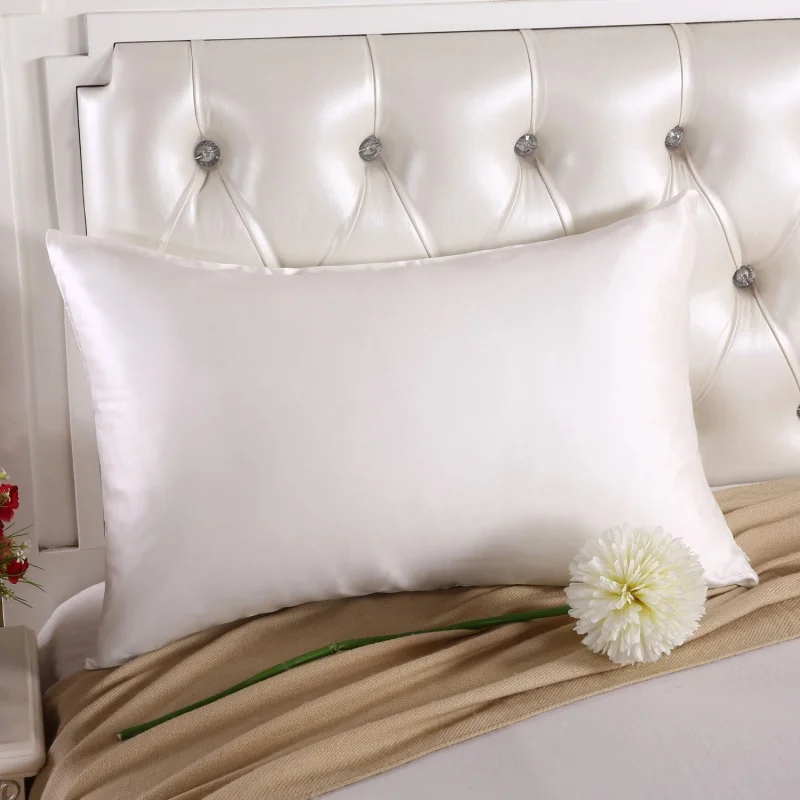
Conclusion: A Simple Change for Transformative Results
The simple act of changing your pillowcase material can have a profound impact on your hair’s health, appearance, and manageability. This small adjustment requires no additional time in your daily routine yet delivers benefits that accumulate night after night.
While silk stands as the premium choice for its unmatched combination of benefits, high-quality satin and bamboo offer excellent alternatives depending on your specific priorities, budget, and values. Each material provides significant improvements over traditional cotton.
At Sanctuary Soft, we believe that true luxury lies in choices that enhance your well-being effortlessly. By selecting the right pillowcase material for your hair type and needs, you’re making an investment in both your hair’s health and your daily confidence.
Make the switch today, and experience the difference that thousands have already discovered—healthier, more manageable, and more beautiful hair, simply by changing what you sleep on.

